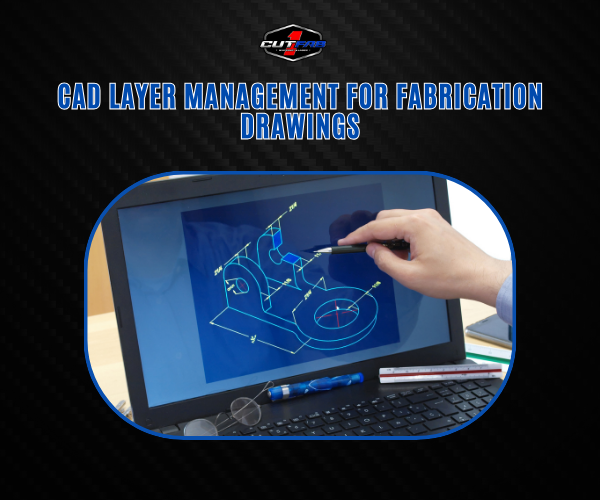
CAD Layer Management for Fabrication Drawings!
In fabrication, clarity is everything. A single misstep in your CAD drawing—like confusing cut lines with bend lines—can cost hours of production time and wasted material. That’s where CAD layer management fabrication comes in. By organizing elements into well-structured layers, designers ensure that every stakeholder, from engineers to machinists, reads the same “language” in the drawing. Layers reduce errors, speed up revisions, and create a cleaner workflow. Think of it as the foundation of digital fabrication: if your layers are messy, your entire process is at risk. Get them right, and fabrication runs smoother.
Standard Layer Conventions (Cut, Bend, Marking)
When it comes to CAD layer management fabrication, consistency is the key to efficiency. Every shop may develop its own standards, but most follow a common set of conventions that keep communication crystal clear across teams and machines. The three most essential layers in fabrication drawings are cut, bend, and marking.
-
Cut Layer: This layer defines the geometry that will actually be cut from the raw material. Typically shown in bold or specific colors (often red), the cut layer tells CNC machines exactly where the material ends. A poorly managed cut layer can result in parts that don’t fit, wasted sheet metal, or costly rework.
-
Bend Layer: Fabrication often requires precision bends. The bend layer, usually represented with dashed lines or a unique color (blue or green), ensures press brake operators know exactly where folds need to occur. Without a clearly defined bend layer, alignment errors can compound, leading to rejected parts.
-
Marking Layer: Marking (or engraving) layers are used for part IDs, assembly notations, or guidelines for downstream processes like welding. These are non-destructive references but vital for operators who need quick visual cues.
By sticking to standard conventions, you reduce confusion, eliminate misinterpretation, and streamline handoffs between CAD designers and fabrication technicians. Standardization also allows automated CAM software to recognize features instantly, boosting productivity.
Organizing Multi-Part Assemblies with Layers
As fabrication projects grow more complex, managing multi-part assemblies becomes a challenge. Without a structured approach to layers, your CAD file can quickly turn into chaos—overlapping details, unclear part boundaries, and endless back-and-forth with the shop floor. That’s why smart CAD layer management fabrication strategies are critical for assemblies.
The goal is simple: create a visual hierarchy that allows anyone opening the drawing to immediately understand which parts belong where, and how they interact. Start by assigning each major component group its own layer set (for example, “Frame,” “Panels,” “Fasteners”). Within those, maintain the standard sub-layers—cut, bend, and marking—to preserve clarity.
This layered approach does two things:
-
Speeds collaboration – Engineers, machinists, and quality inspectors can toggle layers on or off to see exactly what matters to them.
-
Reduces mistakes – No more guessing whether a line represents a cutout in the panel or a bend in the frame.
Another best practice is color-coding different assemblies. For instance, structural parts may be dark tones while secondary brackets or hardware use lighter shades. This helps teams visually distinguish components in seconds, especially when dealing with large-scale sheet metal projects.
When your assembly layers are clean and organized, fabrication workflows become faster, smoother, and far less prone to error. In short: layers aren’t just a drawing tool—they’re a collaboration tool.
Exporting Layer Data for CAM Software
Creating organized layers in CAD is only half the battle—the real payoff comes when you export those layers into CAM software. In fabrication, machines don’t “guess” what a line means. They rely on structured data, and proper CAD layer management fabrication ensures that cut, bend, and marking instructions translate seamlessly into CNC programs.
Most modern CAM tools can automatically detect and assign machining operations based on layer definitions. For example, lines from the cut layer are interpreted as tool paths for lasers or waterjets, while the bend layer can generate press brake instructions. If your layers are inconsistent or mislabeled, the CAM output will be flawed, forcing costly manual corrections.
Best practice: always export in formats your CAM software handles natively, such as DXF or DWG, and double-check that layer naming conventions match shop standards. A clean export minimizes translation errors, accelerates nesting, and reduces programming time.
By treating layer management as a bridge between design and machining, you make the entire digital-to-physical workflow faster, leaner, and more reliable.
Conclusion: Best Practices for Fabricators and Designers
Strong CAD layer management fabrication practices are the backbone of efficient, error-free manufacturing. Whether you’re designing a single bracket or a full multi-part assembly, the way you organize, label, and export layers directly impacts how smoothly production runs. For designers, this means committing to clear conventions—using distinct layers for cut, bend, and marking, applying consistent colors, and avoiding unnecessary clutter. For fabricators, it means ensuring CAM software is calibrated to read those layers correctly, and providing feedback when inconsistencies appear.
The best results come from collaboration. When both sides—designers and shop floor operators—speak the same “layer language,” mistakes are minimized, turnaround times improve, and material waste is reduced. Think of layers as more than lines on a screen; they’re communication channels between digital intent and physical output.
If you want cleaner workflows, fewer revisions, and higher-quality parts, prioritize CAD layer management—it’s a small habit that drives big results.
